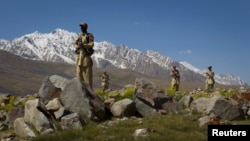A middle-aged lawyer, Nia Beg, is anxious after a large incursion by Islamist militants rattled his homeland in northwestern Pakistan this month.
Beg is Kalash, and he follows the ancient pagan religion practiced in Bumburet and other remote valleys collectively called Kalash in the northwestern district of Chitral, which borders eastern Afghanistan.
He says that attacks by scores of Tehrik-e Taliban Pakistan (TTP) on several villages in Kalash pose hard questions about the security of Chitral, which had rarely seen Taliban violence and is one of Pakistan's top tourist destinations because of its unique culture and natural beauty.
"My children ask me, 'How will we now go to school or walk freely in our village?'" he told RFE/RL's Radio Mashaal after the Taliban incursion into Chitral that began on September 6.
Pakistan claimed to have repulsed the attack and forced the TTP militants to retreat into Afghanistan.
On September 6, the military said four soldiers and 12 militants were killed in clashes. In a sign that all was not well in Chitral, the government imposed a three-day curfew in the mountainous region.
On September 10, the military said it killed seven more militants in ongoing "sanitization" operations. Gunship helicopters were also used, which suggests some of the TTP militants were well entrenched.
"Residents of Kalash are extremely frightened because the Taliban are religious extremists," Abdul Majeed Qureshi, a local Muslim leader, told Radio Mashaal.
"We want the Taliban attacks to end permanently," he added.
The once-peaceful Chitral region now appears to be in the crosshairs of the TTP, whose insurgency has grown remarkably after its ideological and organizational ally, the Afghan Taliban, returned to power in Afghanistan two years ago.
Experts say the surprise incursion into Chitral showcases the TTP's attempt to reestablish a territorial foothold in Pakistan.
After its emergence in 2007, the TTP controlled large areas in the northwestern Khyber Pakhtunkhwa Province. But by 2014, Islamabad's military operations had forced it to flee into neighboring Afghanistan, which shares a more than 2,600-kilometer border with Pakistan.
"Chitral's complex terrain and geographical importance made it a significant option for the TTP to challenge the state’s territorial control," said Abdul Sayed, a Sweden-based researcher who tracks the TTP.
"The TTP's attack on Chitral is part of its ambition to establish a stronghold on the Pakistani side of the border," he added.
Chitral, now divided into Upper and Lower Chitral districts, consists of high-altitude valleys in the Hindu Kush Mountains. It borders the eastern Afghan provinces of Kunar, Nuristan, and Badakhshan. A narrow strip of Afghan territory separates it from China and Tajikistan, which gives the region great strategic significance.
"The TTP wants to carve out a new safe haven that could serve its objectives," said Ihsanullah Tipu Mehsud, director of news at Khorasan Diary, a website tracking militant groups in Afghanistan and Pakistan.
Mehsud argues that the TTP's incursion into Chitral "is very dangerous" because the group might want to carve out other sanctuaries in the Khyber Pakhtunkhwa and Balochistan provinces, which form Pakistan's western border with Afghanistan.
After its emergence in 2007 as an umbrella alliance of Pakistani Taliban groups, the TTP swiftly extended its control over large parts of the South Waziristan, North Waziristan, Mohmand, Bajaur, and Swat districts in Khyber Pakhtunkhwa.
Years of TTP attacks and the Pakistani Army's counterinsurgency killed more than 80,000 Pakistanis, predominantly ethnic Pashtuns. The violence also displaced more than 6 million Pashtuns.
"The TTP is seeking to restore some of the territorial control it once enjoyed in regions such as Swat and Waziristan," Mehsud said.
TTP violence has risen dramatically since the Taliban seized power in Afghanistan in August 2021. The Taliban-led government brokered negotiations between Islamabad and the TTP, but these ended in November after the TTP formally declared that its cease-fire with Islamabad was over.
According to the Pakistani Institute for Conflict and Security Studies, a think tank in Islamabad, this August was the most violent month since November 2014.
The TTP claimed some 147 attacks that month. During the first eight months of the year, 227 Pakistanis were killed and 497 were injured in 22 suicide attacks, mostly claimed by the Pakistani Taliban.
The Pakistani military and law enforcement have endured mounting losses. At least 120 soldiers and military officers were killed in militant attacks in the first six months of this year. The police, particularly in Khyber Pakhtunkhwa, have had similar losses.
Rising TTP violence has sharply deteriorated relations between longtime allies Pakistan and the Afghan Taliban.
Islamabad swiftly closed its main border crossing with Afghanistan in Torkham, which is some 400 kilometers to the south. It has also launched a crackdown on an estimated 3 million Afghan refugees and migrants in the country.
“We expect the Afghan interim authorities…to ensure that Afghan territory is not used as a launching pad for terrorist attacks against Pakistan," said the Foreign Ministry in Islamabad on September 11 in response to a Taliban statement demanding the reopening of Torkham.
The border crossing was reopened on September 15.
Sayed said the mountainous border between Chitral and the eastern Afghan province of Nuristan comprises deserted areas known as No-Man's Land.
“This could give the Afghan Taliban the pretext that the TTP has not attacked from areas under their control,” he said.
Mehsud said the TTP attack was also encouraged by the relatively small presence of security forces in Chitral. It is also the only region where the Pakistani border fencing with Afghanistan is incomplete.
"Things are reaching a boiling point between the two countries," Mehsud noted. "Pakistan might launch surgical attacks or kinetic actions inside Afghanistan to target the TTP leaders and their bases."
On September 10, an improvised explosive device targeted a senior TTP commander, Badshah Khan, in the southeastern Afghan province of Paktika.
In Chitral, civilians remain anxious in the aftermath of the TTP attack.
"People are worried that if the Taliban continues to attack, tourists will stop coming," said Ihkamuddin, a local politician in Bumburet.













